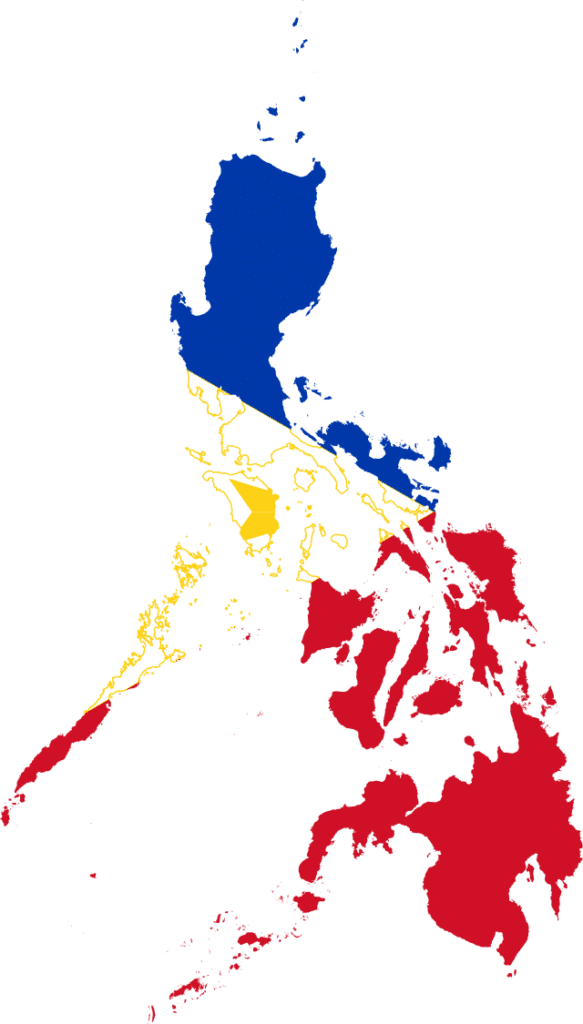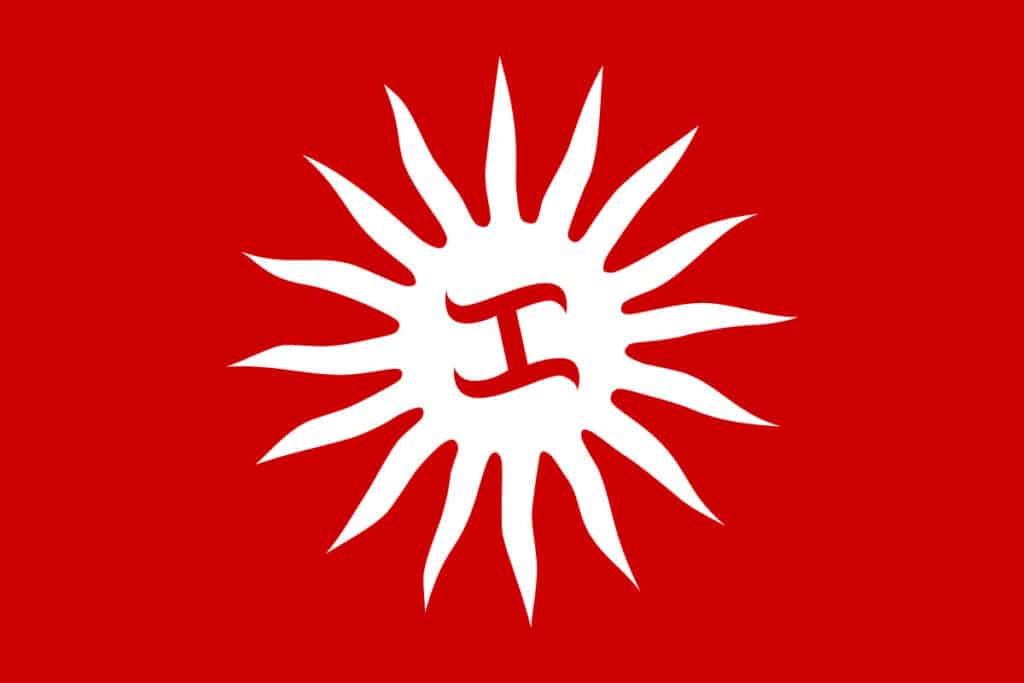The Philippines, an energetic archipelago tucked away in Southeast Asia, is a nation abounding in natural beauty and cultural riches. The Philippines Flag is a representation of the country’s identity and ambitions. This article explores the historical relevance, aesthetic components, and rich symbolism of this nation’s flag to reveal the enthralling tale behind it.
Let’s explore the journey that illustrates the enduring pride and tenacity of the Filipino people, as symbolized by the flag’s colorful designs and significant symbolism.
Philippines: Country Profile
The Philippines flag is a wonderful representation of the country’s culture, history, and traditions. The beautiful archipelago of the Philippines is located in Southeast Asia. The Philippines is a magnificent destination that enthralls visitors and captures hearts all over the world with its interesting combination of history, diversified topography, dynamic demographics, and rich cultural tapestry.
Geography of the Philippines
The Philippines is an archipelago made up of over 7,000 islands, each of which has stunning natural wonders and scenery. Visitors are mesmerized by the country’s varied geography, which ranges from the magnificent beaches of Boracay and Palawan to the spectacular rice terraces of Ifugao. Towering volcanoes, rich jungles overflowing with unique wildlife, and crystal-clear waterways harboring beautiful coral reefs are also found there.
The Philippine Standard Time (PST) zone, which is UTC+8, is where the Philippines are situated. The whole nation observes this time zone, including important cities like Manila, Cebu, and Davao. The time in the Philippines is constant throughout the year since there is no DST.

Population
The population of the Philippines is vibrant and culturally varied. The nation, which has a population of more than 110 million, benefits from its diverse range of languages and nationalities. Filipinos are well known for their friendliness, generosity, and a strong sense of belonging. There are many different ethnic groups in the country, with the Tagalog people constituting the majority.
The Visayans, Ilocanos, Bicolanos, and Mindanaoans are more noteworthy ethnic groups. Filipino, the official language, and English are extensively used and act as bridge languages between the various populations.
Cultural Legacy
The Philippines’ cultural legacy is a tapestry made up of native customs, Spanish colonial influences, and modern-day trends. The confluence of indigenous, Malay, Spanish, and American components in the culture of the Philippines has resulted in a distinct and vivid identity. Festivals like the Ati-Atihan in Kalibo and the Sinulog in Cebu, which feature raucous parades, vibrant costumes, and traditional music and dance, demonstrate the country’s vivacious personality. The Philippines is renowned for having a thriving arts sector that includes theater, cinema, visual arts, and literature.
Filipino cuisine is a vital aspect of the culture, with tastes that represent the nation’s rich background. With its distinctive fusion of tastes and spices, Filipino food tantalizes taste buds with dishes like the savory beef dish adobo and the tangy soup sinigang. Most Filipino dinners include rice, which is frequently complemented by a variety of mouthwatering vegetables and delicacies.
Brief History Of the Philippines
The colonial history of the Philippines is an engrossing tale of victory over adversity. Up until 1898, when the country formally declared its independence, it had been a Spanish colony for more than three centuries.
Jose Rizal and General Emilio Aguinaldo led a valiant revolt against Spanish authority that is indelibly woven into the history of the Philippines. Later, the Philippines experienced American colonialism and occupation, which had a profound impact on its growth.
Design & Symbolism
Colors
The vibrant blend of red, white, and royal blue makes up the Philippines flag. The vivid colors represent the spirit of the country and inspire a sense of patriotism. The red stripe is a continual reminder of the sacrifices made by the Filipino people and stands for patriotism, bravery, and heroism.
The white stripe stands for purity, peace, and the nation’s high ideals. Last but not least, the royal blue field stands for constancy, accuracy, and justice – a lighthouse that points the Filipino people in the direction of a civilized society.
Dimensions
The flag is rectangular and has a ratio of 1:2, which means that the breadth is precisely twice as long as the length. It is separated into two horizontal pieces, with a royal blue top stripe and a red bottom stripe. The hoist side of the flag has an equilateral white triangle that runs from top to bottom.
A golden-yellow sun with eight rays, each of which stands for a province important to the Philippine Revolution, is prominently featured within the triangle. A three-star constellation that represents the three major geographical areas of the Philippines – Luzon, Visayas, and Mindanao can be seen near the center of the sun.
Symbolism
The Philippines flag contains a wealth of symbolic meaning that dates back centuries. The royal blue stripe serves as a reminder to the Filipino people of their need to maintain the virtues of peace, truth, and justice. The crimson stripe stands for the valor and dedication of all the warriors who battled to secure the country’s freedom. It acts as an ongoing reminder of the resilient spirit that permeates the Filipino people.
The ideas of liberty, equality, and fraternity are represented by the white equilateral triangle. It represents the solidarity of the Filipino people in their desire for a just and progressive country, irrespective of their upbringing or religious convictions. The eight-rayed, golden-yellow sun stands for liberation, hope, and the never-ending quest for independence. The three-star constellation in the middle of the sun stands in for the many geographical areas that make up the Philippines, highlighting both the country’s variety and its togetherness.
History of The Philippines Flag
First Philippines Flag “Magdalo Flag”
General Emilio Aguinaldo created the initial design of the flag, also known as the “Magdalo Flag,” during the Philippine Revolution to overthrow Spanish colonial power. It had three stars and a white sun on a red background, representing the provinces of Manila, Bulacan, and Cavite. On May 28, 1898, at Kawit, Cavite, this flag was first flown as a sign of resistance and the Filipino people’s desire for freedom.

“Lone Star Flag”
The “Lone Star Flag” underwent a considerable change as the revolution grew more intense. General Aguinaldo declared the nation free of Spanish authority on June 12, 1898, and a new flag called the “Lone Star Flag” was displayed the same day. The colors red, white, and blue were still present, but this flag now included a single white five-pointed star in the middle of the red field to symbolize the unification of the Filipino people.
The “Philippine Insurgent Flag”
After the Spanish-American War, the United States acquired control of the Philippines, posing a new threat to the Filipino insurgency. To symbolize this new period, the flag received another alteration.
The “Philippine Insurgent Flag” was first displayed in 1899 and had a horizontal red stripe, a single white five-pointed star, and the blue canton of the American flag. The goal of this design was to show how well the American and Filipino rebels worked together.
The “National Flag”
To create a uniform design for the national Philippines flag, a Commission on the Philippines flag was constituted in 1907. As a result, the “National Flag,” which is quite similar to the present flag, was made. On the hoist side, it had a white equilateral triangle with three stars and a golden-yellow sun in the middle, signifying liberty, equality, and fraternity. The number of sun rays was expanded to eight to symbolize the eight provinces that were crucial to the success of the Philippine Revolution.

Resistance During The American Colonial Era
The United States government forbade the flying of the Philippines flag during the American colonial era because they saw it as a sign of uprising. Despite this limitation, the Filipino populace persisted in supporting their flag and clandestinely wearing it during demonstrations and other acts of resistance against colonial authority.
Independence & the Recognized “Philippines Flag”
The Philippines attained complete independence from the United States on July 4, 1946. The flag, which is now referred to as the “Philippines Flag,” was raised aloft as a sign of the country’s struggle for freedom and the start of a new era.
Standardization & Flag Day
In order to ensure the flag’s uniformity and correct display, legislation was passed in 1998 that clarified its design and requirements. The ordinance also designated June 12 of each year as “Flag Day,” acknowledging the significance of the flag’s raising in 1898 and celebrating it.
The Philippines flag still flies proudly today, serving as a potent symbol of the nation’s rich history, strong spirit, and unflinching desire for independence.
Bottom Line
The Philippines Flag is an everlasting symbol of the country’s perseverance and unwavering quest for freedom. Its striking colors and strong symbols convey a message of adversity, perseverance, and unshakable patriotism.
We begin to comprehend this treasured national emblem’s great significance to the Filipino people as we begin to peel back the layers of history and symbolism that are present there. The Philippines passionately embraces its legacy and looks to a future characterized by peace and togetherness with each raising of the Philippines flag.